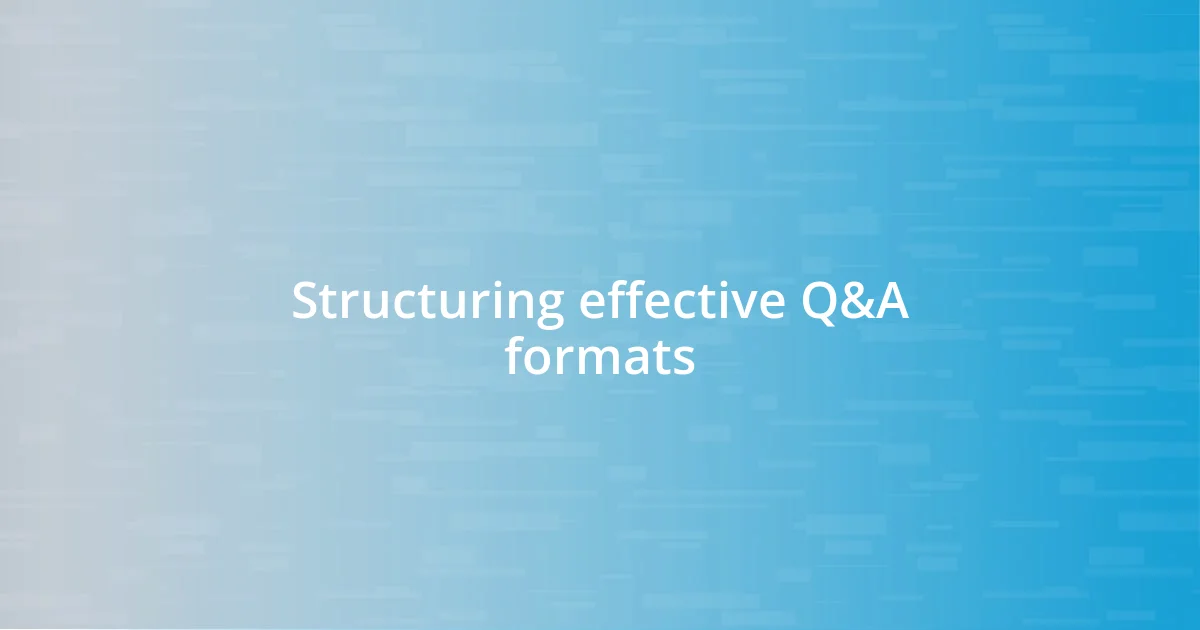Key takeaways:
- Preparation and audience understanding are crucial; tailoring content and anticipating questions can enhance confidence and effectiveness in Q&A sessions.
- Engaging techniques like active listening, personalized responses, and storytelling can significantly foster a sense of community and encourage participant interaction.
- Continuous evaluation and improvement are essential; assessing outcomes, managing time effectively, and incorporating diverse question formats can lead to more enriching future sessions.

Preparing for Q&A sessions
Preparing for a Q&A session can be a bit nerve-wracking, but I’ve found that having a solid game plan makes all the difference. I usually spend time reviewing the content and anticipating potential questions. Is there anything more daunting than being blindsided by a question you didn’t see coming? I remember one session where I felt completely unprepared, and it taught me the value of foresight.
It’s not just about knowing your material; it’s also about understanding your audience. I once tailored my preparation based on the questions that were frequently asked by this particular group. Engaging with them beforehand helped me feel more connected and confident. Have you ever thought about how a little bit of empathy can transform your approach?
Visual aids can also be a lifesaver during these sessions. I’ve experimented with everything from slides to props, and I noticed that they truly enhance comprehension. When I included a quick visual to clarify a complex point, it not only helped my audience but also eased my own nerves. So, what strategies have you tried to make your Q&A sessions more effective?

Structuring effective Q&A formats
Structuring effective Q&A formats is crucial for fostering an engaging and informative experience. I’ve found that having a clear structure can often dictate how smoothly a session flows. For example, during one particularly memorable session, I established a three-part format: opening questions, group discussion, and closing remarks. This deliberate organization not only kept the conversation focused but also allowed participants to feel heard and valued.
When it comes to the actual questioning process, I like to encourage open-ended queries. Instead of asking, “Do you understand this concept?” I prefer, “What are your thoughts on this concept?” This subtle shift invites more detailed responses. During one session, I remember a participant sharing a perspective that changed the direction of our discussion entirely. It reinforced my belief that effective Q&A formats should promote dialogue rather than a simple Q&A.
Lastly, time management is essential. I aim to allocate specific time slots for each segment of my Q&A session; this helps in maintaining momentum and keeping participants engaged. In one instance, I found myself running over time due to an unexpected surge of questions. While it was great to see such enthusiasm, I learned to be more vigilant about pacing. It’s all about respecting the audience’s time while ensuring everyone gets a chance to speak.
| Q&A Format | Description |
|---|---|
| Structured Approach | Breaks the session into segments for clarity |
| Open-Ended Questions | Encourages deeper discussion and insight |
| Time Management | Ensures a smooth flow and engagement |

Engaging your audience effectively
Maintaining audience engagement during a Q&A session is an art I have come to appreciate over time. I recall a moment when I took a few minutes at the beginning of one session to share a story that resonated with the theme. The room’s energy shifted instantly; it was as if I had invited everyone into a more personal conversation. I’ve seen how sharing a genuine experience sparks connections, encouraging participants to open up and share their own insights.
Here are some effective techniques that have worked for me:
- Active Listening: I make it a point to listen attentively to participants, nodding and acknowledging their contributions. This approach signals that their thoughts are valued, fostering a sense of community.
- Personalize Responses: I aim to tailor my answers to specific individuals when I can. In one session, I noticed a participant hesitating before asking a question; by addressing their concern directly, I helped create a more comfortable atmosphere.
- Encourage Participation: I love to invite quieter members to share their views, often asking, “I’d love to hear your thoughts on this!” This simple nudge has brought some of the most profound insights to light.
I’ve learned that creating an engaging atmosphere in Q&A sessions requires a blend of empathy, personal connection, and attentiveness to the audience’s cues.

Handling challenging questions
Handling challenging questions is a skill that often comes with a bit of practice and confidence. I remember a time when a participant threw a curveball my way, asking a complex question that got to the heart of a sensitive topic. In that moment, I took a deep breath, acknowledged the weight of their inquiry, and said, “That’s a great question, let’s explore it together.” By framing it this way, I not only bought myself a moment to gather my thoughts but also reassured the audience that we were all in this as a team.
During another session, I faced a situation where a participant challenged my previous statements quite pointedly. Taking it in stride, I welcomed the challenge and replied, “I appreciate your perspective; can you share what led you to that conclusion?” This approach shifted the dynamic from confrontation to collaboration. I’ve learned that engaging respectfully with tough questions can transform potential conflict into a rich discussion, leaving everyone feeling valued and heard.
When I encounter questions that are particularly tough or emotive, it’s crucial for me to remain calm and composed. I often visualize myself as a bridge; my role is to connect the questioner’s concerns with the broader ideas being discussed. For instance, one participant once expressed a deep concern about the applicability of our topic in real-life scenarios. By connecting their concern to practical examples, I could see their apprehension fade, replaced by interest and curiosity. It made me realize how important it is to be empathetic and responsive, always aiming to align my answers with the audience’s needs and emotions.

Techniques for clear responses
One technique I often rely on is the power of clarity. When I respond to questions, I make it a point to use simple language, avoiding jargon that could alienate listeners. For instance, during one session, I was asked about a sophisticated concept related to our discussion, and instead of diving deep into technical terms, I broke it down into everyday language. The relief on the audience’s faces was palpable; they appreciated that I wasn’t condescending but genuinely focused on making the topic accessible.
I also believe in the importance of pausing before answering. There’s something about taking a brief pause that gives both me and the audience a moment to reflect. One memorable experience was when I encountered a particularly loaded question. I took a deep breath and paused to collect my thoughts, allowing time for the tension to ease. When I finally responded, my answer felt measured and intentional, resulting in a more thoughtful discussion that followed.
Visual aids have become a staple in my Q&A sessions as well. I vividly remember a time when I used a diagram to explain a complex process. As I pointed to each section, I could see the audience following along, their eyes lighting up with understanding. It made me realize that these visual aids not only enhance clarity but also encourage engagement; I often find myself asking, “Does this visual help clarify your question?” This invites further dialogue and deepens everyone’s involvement in the topic.

Evaluating Q&A session outcomes
Evaluating the outcomes of a Q&A session is an integral part of the process for me. After each session, I spend some time reflecting on how well the questions were addressed and whether the audience seemed satisfied with the responses. For example, I once conducted a session focused on a complicated project, and I noticed that the energy shifted drastically after I provided thorough explanations. That’s when it hit me—evaluating the effectiveness of my responses isn’t just about content; it’s also about the emotional resonance with the audience.
Sometimes, I even ask participants for feedback directly after a session. A couple of times, I’ve ended with, “Did I meet your expectations today?” Hearing their responses gives me invaluable insight—not just about the clarity of my answers but also how well I connected with them emotionally. On one occasion, a participant shared that a particular answer had ‘opened their eyes’ to a new perspective. It motivated me to dig deeper into how I can better engage the audience in future sessions.
I’ve come to understand that outcomes aren’t purely based on the questions asked; they encompass the overall vibe of the session. Was there laughter? Were there thoughtful nods? Did participants engage with each other during the discussions that followed? Reading the room and gauging these reactions offer me lessons that spreadsheets and metrics simply can’t capture. Each session becomes a learning opportunity, prompting me to ask, “How can I make the next experience even more enriching for everyone involved?”

Improving future Q&A sessions
Improving future Q&A sessions often starts with an honest assessment of what worked and what didn’t. I remember a time when I realized I had overlooked a fundamental aspect: the importance of managing time effectively. One session felt chaotic because I rushed through questions, leaving many unanswered. Now, I make it a point to allocate time clearly, ensuring that each participant feels their question is valued. I ask myself, “How can I create a more structured environment that allows everyone to contribute?”
Another approach I find beneficial is incorporating a variety of question formats. During one memorable session, I introduced a mix of verbal and written questions, and it transformed the dynamic significantly. Participants who might have hesitated to speak up felt more comfortable writing their thoughts down. This shift not only encouraged more input but also led to some insightful discussions. It reminded me that diversity in how questions are asked can enhance engagement—what’s stopping me from experimenting more with formats in the future?
It’s also vital to foster a sense of community among participants. I vividly recall a session where I invited attendees to share their experiences related to the topic, sparking a rich exchange that exceeded my expectations. The energy was electrifying, with people connecting over shared challenges and insights. I’ve since prioritized creating opportunities for these interactions, as they can deepen understanding and reinforce a collective learning experience. How can I leverage these moments to build stronger networks in future Q&A sessions?
















